
Click the button to start reading
Beyond Airtable: Exploring The 9 Best Project Management Alternatives
Are you tired of feeling limited by Airtable’s features or pricing? Or are you just looking for an alternative that better meets your project management needs?
Look no further! In this article, we’ll explore the top alternatives to Airtable. We’ll compare features, prices, and ease of use so you can choose the right PM tool for you and your team. From project management software like Teamly and Trello to spreadsheet-based programs like Smartsheet and Microsoft Excel, we’ve got you covered.
In this post, we’ll uncover the nine best alternatives to Airtable and evaluate their features, functions, and potential. It’ll be a thorough investigation that will ultimately lead you to make an informed decision about which alternative is best for your team’s requirements and pain points.
So, without further ado–let’s dig in!
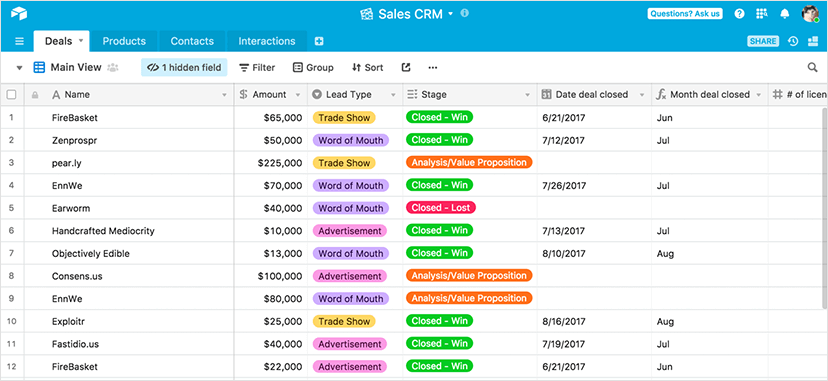
But first, what’s Airtable?
Airtable is a popular tool that bridges the gap between spreadsheets and databases. Founded by former Salesforce Product Manager Howie Liu, it became publicly available in 2015 after three years of hard work and investment from prominent investors such as Caffeinated Capital and Andreessen Horowitz.
This online SaaS platform allows users to build collaborative apps without any coding knowledge. It’s like the perfect marriage between spreadsheets and databases, combining the best of both worlds. It provides workspaces and bases that can be shared with teams regardless of size.
Note: Workspaces are collections of projects, while bases act as hubs for particular projects or workflows.
Users can customize tables within a base that are linked together to create dynamic relationships. These can then be shared with other team members for collaboration in grid, calendar, form, kanban, and gallery views. Pro and Enterprise Airtable users also have access to Gantt and timeline views.
Howie Liu had the idea for Airtable while he was working at Salesforce. It helps users manage tasks, work together as a team, and organize resources in a way that doesn’t require them to know how to code.
Airtable’s limitations for Project managers
Although Airtable may boast several capabilities, it’s not an optimal solution for project management due to certain restrictions. For instance, commenting on individual records can be laborious and inefficient when finding relevant information.
Furthermore, the absence of a standard communication system renders this tool inadequate for collaborative teams that require frequent interaction between members.
Secondly, while Airtable allows users to have different levels of access, it doesn’t offer the ability to restrict users to specific views or table columns, forcing users to find workarounds.
This can be particularly challenging for organizations working with sensitive information. Additionally, Airtable is not specifically designed for project management, so it may not be the best choice for organizations with large and complex projects.
Finally, some users have reported issues embedding visual, media, or interactive content, which can pose a challenge for companies that regularly deal with large volumes of images or videos.
While Airtable offers flexibility and customization options, it may not fit every team’s needs best. That’s why exploring other alternatives is important so you can find the best fit for your team…
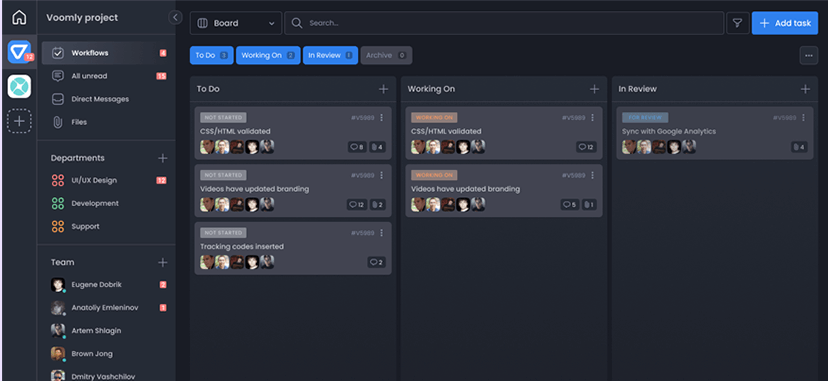
1. Teamly
Teamly is a complete solution for managing remote teams that gives teams everything they need to stay organized and get work done. With its intuitive interface and powerful features, Teamly makes it easy to manage tasks, track progress, and collaborate with team members remotely.
Features
Teamly offers a range of robust features for team and task management, including:
- Real-time chat
- Time tracking for monitoring employees
- Screen capture video with audio recording
- Templated checklists and SOP documents.
- Task assignment and kanban boards
- Built-in collaboration tools
Downside to Teamly
Though Teamly is the all-in-one project management solution, it does have one notable downside when comparing it to Airtable…
- Lacks the spreadsheet feature.
Comparison of Teamly to Airtable
If the inability to build out spreadsheets is a deal breaker, then Airtable is likely the better choice.
But if you’re looking for the necessary team and task management features, then Teamly might be the right fit. It provides users with many benefits, such as an intuitive interface and robust features that are tailored toward remote teams.
In addition, Teamly’s video and audio recording capabilities let you track progress in real-time, while its templated checklists and SOP documents help teams stay organized and efficient.
Ultimately, if you’re looking for an all-in-one project management solution to help remote teams stay organized and get work done quickly, then Teamly is the way to go.
Pricing for Teamly
Teamly has two paid versions, Teamly Pro and Teamly Business, and a free version with limited features (but good enough to get started). Depending on whether you pay month by month or make an annual commitment, pricing ranges from $5 to $9 per user, per month.
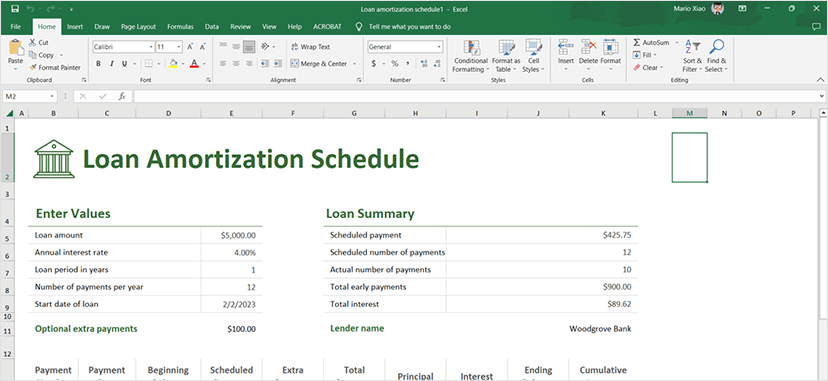
2. Microsoft Excel
Why not just use Excel? It’s a common question when it comes to project management software, as Excel is a widely used and familiar tool for many professionals. However, Excel has its limitations when it comes to project management and collaboration.
Essentially, Excel is spreadsheet software that is part of the Microsoft Office Suite. It is primarily used for data entry, analysis, and visualization. It allows users to create and edit spreadsheets, charts, and tables and also includes basic calculations and formulas.
Features
- Customizable spreadsheets and charts
- Basic calculations and formulas
- Data visualization tools
- Ability to link multiple spreadsheets
- Collaboration through shared workbooks
Downside to Excel
While Excel is a powerful tool for data management and analysis, it falls short when it comes to project management. Some of the limitations of Excel include:
- Limited task management capabilities
- Lack of built-in workflow automation
- Limited collaboration and communication tools
- No native mobile app
- No built-in time tracking or time management features
Comparison of Excel to Airtable
Excel is a great tool for data analysis, but it lacks the project management features found in Airtable. Excel also falls short when it comes to collaboration and communication tools as well as workflow automation.
Airtable, on the other hand, offers all of these features plus more, such as customizable views and formulas, task management capabilities, and time tracking. Airtable also provides a native mobile app for iOS and Android, making it perfect for teams who need to be able to access their project information on the go.
Ultimately, when it comes to project management, Airtable is a better choice than Excel as it offers more features and flexibility that are tailored toward managing projects and teams.
Therefore, if you’re looking for a better alternative to Excel for project management, Airtable is the way to go.
Pricing for Featured Software
Excel is part of the Microsoft Office Suite, and is included with an Office 365 subscription. Microsoft Excel: $6-16 per user, per month (depending on plan).
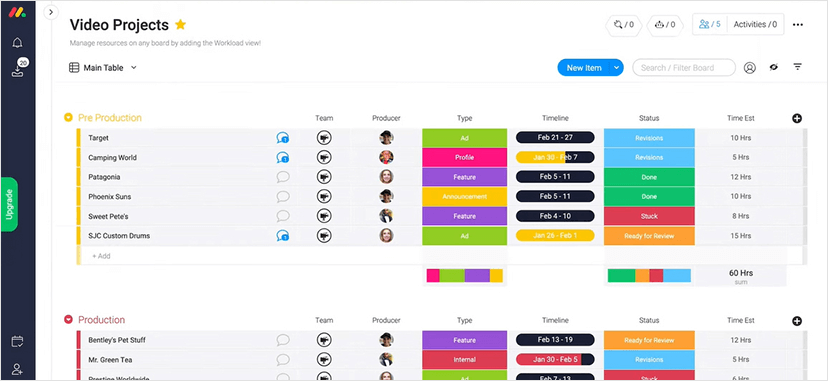
3. Monday.com
If you haven’t heard of Monday.com, it’s one of the most popular cloud-based work operating systems. It was launched in 2012 by Roy Mann and Eran Zinman, under the name dapulse but underwent a name change in 2017 to become what we know today as Monday.com.
Monday.com is a comprehensive work management tool that you can use for various purposes, from project management to sales, HR, operations, IT, and more. The tool operates using boards, which work similarly to spreadsheets, but with a more visually appealing interface.
With Monday.com, you can customize your boards with columns for tracking progress, time, due dates, assignees, and more. The rows, called items, can be anything from tasks to activities; it’s up to you.
And, if you’re looking for a different view of your work, Monday.com has got you covered with a range of visualization options such as files, maps, timelines, Gantt charts, workload, chart, form, calendar, and Kanban. So, whether you’re working on a content calendar, preparing for a product launch, or tracking software development, Monday.com is the ideal solution for you.
Features
- Visual project boards for task management
- Built-in team communication and collaboration tools
- Multiple views to customize your workflow
- Customizable fields, formulas, and automation workflows
- Integrations with other apps such as Google Calendar, Slack, Trello and more…
Downside to Monday.com
- Membership limitations
- Limited dependencies for tasks
- Confusing pricing
- Lacks user-friendly interface
Comparing Monday.com with Airtable
When it comes to features, Monday offers many of the same ones available in Airtable such as viewing team progress in real-time or building custom databases but also uniquely adds visual elements like Gantt charts and status indicators which allows users to be more agile with their project management capabilities.
Additionally, Monday eliminates any paywall restrictions and allows users access to all features regardless of pricing plan which is an advantage over other similar solutions such as Airtable.
Finally, Monday provides dynamic scheduling features that are far ahead of what Airtable can offer, allowing teams to sync events with calendars like Google Calendar or Outlook so everyone is always up-to-date on upcoming tasks or deadlines. With different pricing plans ranging from personal use for solo freelancers up to enterprise plans for larger companies; there is a plan for teams of any size.
Pricing for Monday.com
Monday’s pricing plans start at $8 per user, per month for the Standard plan and go up to $16 per user, per month for what they call pro. plan.

4. Trello
Trello is a popular project management tool that allows teams to organize and prioritize tasks in a visual way. It uses a board system, where each board represents a project or a specific area of focus.
Each board contains lists, which are essentially columns, and cards, which represent individual tasks. The cards can be moved around between lists to represent their progress and priority. There are also a lot of integrations and apps that can be added to Trello to make it work better.
Features
- Visual task management using boards, lists, and cards
- Collaboration and communication tools, such as comments and mentions
- Customizable backgrounds and labels for easy organization
- A wide range of integrations and apps available to enhance functionality
- Mobile app available for iOS and Android devices
Downside to Trello
- Trello freemium plan limited to 10 boards and default view
- Power-Ups can add significant expense to Trello
- Not recommended for complex projects as it lacks Gantt charts and key PM features
- Lacks functionality compared to other PM software options with missing features like time-tracking and progress reports.
Comparison of Trello to Airtable
Some things about Trello and Airtable are the same, like how they both have visual tools for managing tasks and collaboration. However, Airtable offers more advanced features such as budget tracking and advanced reporting. Trello is better suited for smaller teams or projects, while Airtable is more suitable for larger, more complex projects.
Pricing for Trello
Trello offers a free and paid plan starting at $5 per user per month for the Standard plan and $17.50 per user per month for the Enterprise tier.
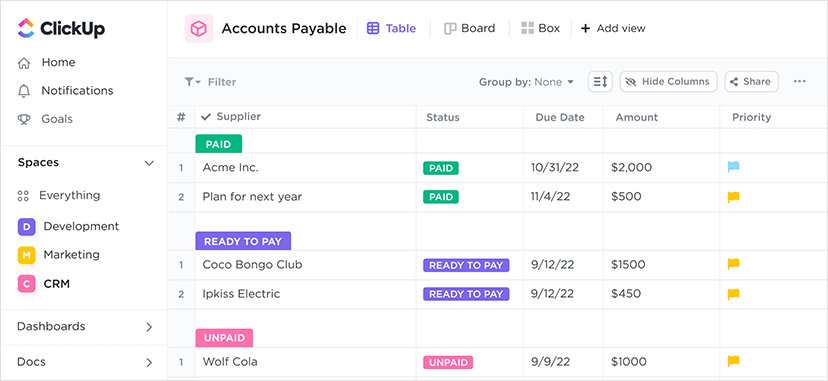
5. ClickUp
ClickUp is a cloud-based project management software that was originally created as an internal tool for a team led by, Zeb Evans.
The team’s initial goal was to create a fraud-proof competitor to Craigslist, but when that idea failed, they shifted their focus to their internal tool, ClickUp. The platform was publicly released in 2017 and is now used by businesses of all sizes for task management, organization, and collaboration.
Features
- Highly efficient dashboard view and collaboration features
- Offers a number of features in its free version that are only available in
- ClickUp’s paid plan, has goals, embedded emails, conditional automation, task checklists, custom task statuses, sprints, and 24/7 support
- Offers native email, several templates, and free integrations
- 15+ views for users, including list, board, calendar, box, Gantt, activity, workload, table, embed view, and more, allowing teams to view project data in several different ways for a better understanding
- Main view is the list view, which is a grid that’s similar to a standard to-do list, featuring key information such as tasks, subtasks, and due dates, as well as the progress of those tasks and who’s responsible for completing them
Downsides to ClickUp
- Despite its many features, some users may find the platform overwhelming and confusing to navigate
- Some users have reported issues with syncing and data loss
- Some users have reported that the platform’s customer support can be slow to respond
Comparison of ClickUp to Airtable
ClickUp offers many features in its free version that is only available in Airtable’s paid plan. ClickUp’s main view is a list view, while Airtable’s main view is a spreadsheet. When deciding which platform is best for your team, it’s a matter of preference.
Airtable has more database management features, while ClickUp is more about managing projects and keeping track of tasks. Some teams might like the flexibility of the spreadsheet view in Airtable, while others might find the list view in ClickUp easier to use.
Pricing for ClickUp
ClickUp offers a free version with limited features as well as a paid version starting at $5 per user per month. The paid version offers additional features such as custom task statuses, goals, and 24/7 support.

6. Smartsheet
Smartsheet is a spreadsheet tool for team collaboration, workflow management, and reporting. It was first made available to the public in 2006, but because it was hard to use, it failed to gain adoption.
In 2010, Smartsheet, Inc. drastically streamlined the features of their SaaS product and unveiled an easier-to-use version that quickly became a hit with users.
Currently, a multitude of companies trusts Smartsheet’s grids to manage their tasks. These grids are like spreadsheets, but they are much more useful because users can delegate tasks, split up jobs, and assign resources.
Features
- Team collaboration and workflow management
- Grids are similar to traditional spreadsheets but with added functionality
- Allocate tasks, define subtasks, and manage resources
- Hundreds of time-saving templates with pre-established workflows, automation, and alerts
- Template sets with prebuilt, customizable sheets, reports, and dashboards
- Multiple data views including card, calendar, and Gantt
Downside to Smartsheet
The main downside to Smartsheet is that it can take some time to figure out how to use it to derive the biggest benefits from the tool.
- Steep learning curve for some users
- No Time Tracking
- Spreadsheet-style interface may not be intuitive for everyone
- No Autosave
- Limited customization options compared to other project management tools
- Limited access to advanced features without upgrading to a higher pricing plan
- Limited integrations compared to other project management tools
Comparison of Smartsheet to Airtable
While both Smartsheet and Airtable come with a learning curve, Airtable tends to be easier to use. Even non-technical users can manage project and workflow data using Airtable’s bases thanks to its simple, colorful interface. Add Airtable’s extensive template options into the mix, and the platform becomes even more straightforward for new users to get up-to-speed with. Users on several review site rate Airtable higher than Smartsheet for ease of use.
Pricing for Smartsheet
Smartsheet offers several pricing plans for its customers, including PRO for $7/month per license, billed annually; BUSINESS for $25/month per license, billed annually with a 3 license minimum and ENTERPRISE and SMARTSHEET ADVANCE, both of which require contact with sales for pricing information.
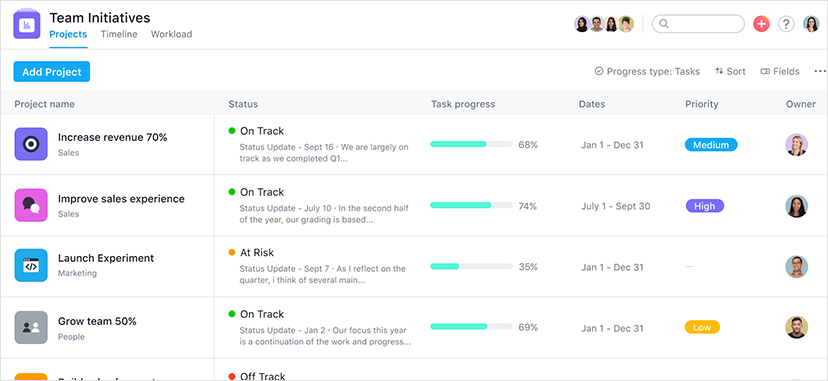
7. Asana
Asana is a popular project management tool that teams use to stay organized and work together. Dustin Moskovitz and Justin Rosenstein created it as a PM tool for use at Facebook. They quit and formed their own company, Asana, in 2008. Since then, Asana has continued to develop its flagship product before launching the software commercially in 2012.
Features
- Multiple views for users, including list, board, and calendar
- Timeline view for premium, business, and enterprise members
- Feature-rich experience
- Helpful structure for managing multiple projects
- User-friendly interface
Downside to Asana
Overall, Asana is a solid project management software with many features, but it has its limits…
- Too many features that ratchet up the complexity
- Less user-friendly with a learning curve
- Subpar customer support
- Cannot assign tasks to multiple users
- Trustpilot reviews rating of 2.7 out of 5, with 36% of users rating Asana as “Poor” or “Bad.”
Comparison of Asana to Airtable
Asana and Airtable are project management tools but have different features. Airtable is more of a database management tool, while Asana is geared more toward project management.
Airtable has more customization options and is excellent for teams managing large amounts of data. Asana, on the other hand, is better for teams that need to manage tasks and workflows.
Pricing for Asana
Asana offers three main pricing options:
Their first tier plan is BASIC, free for teams with up to 15 members. Their next tier is PREMIUM, which is $10.99/month per user, billed annually. Their BUSINESS plan is $24.99/month per user, billed annually. If you are looking for an ENTERPRISE option, then you have to contact their sales department.
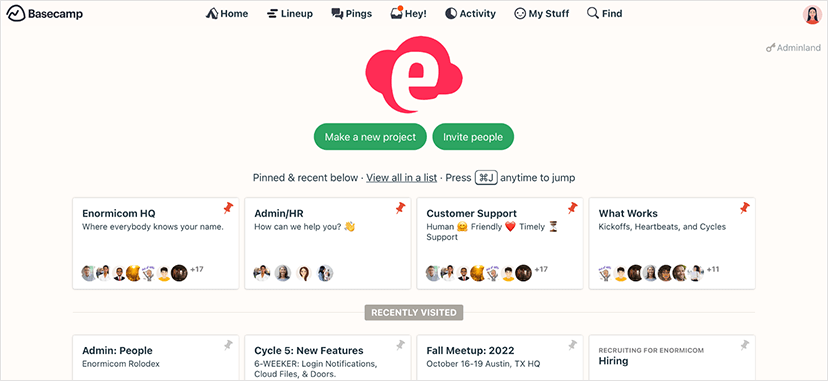
8. Basecamp
Basecamp is a web-based tool used by teams for work management and collaboration. The tool was initially created in 2004 as a project management tool for a web design firm, 37signals. In 2014, the company changed its name to Basecamp. Today, the latest version of the product is known as Basecamp 3.
Although Basecamp is sometimes referred to as a PM tool, it lacks some standard features found in traditional PM software, such as time-tracking, Gantt charts, and board views. In Basecamp, users can create “hubs,” which are essentially repositories of information for either teams or projects. Each hub has six sections: Message Board, To-Do’s, Docs & Files, Campfire (real-time chat), Schedule, and Automatic Check-Ins.
In these sections, users can make group announcements, assign tasks, check due dates, and make their own questions that will be asked of the team at set times. Basecamp also has hill charts that let users see their to-do lists as hills, with the midpoint of a project at the top of the hill.
Features
- Message Board for group announcements
- To-Do’s for task assignments
- Docs & Files for file storage
- Campfire (real-time chat) for communication
- Schedule for deadlines
- Automatic Check-Ins for user-defined questions to be asked to the team at specified intervals
- Hill charts for visualizing to-do lists as hills
Downside to Basecamp
- Lacks time-tracking
- No Gantt charts or board views
- Hill charts are subjective and based on user feelings rather than objective data
Comparison of Basecamp to Airtable
Basecamp and Airtable are both project management tools with different features. While Basecamp is more of a task-oriented tool, Airtable is more of a database management tool.
Airtable has more customization options and allows users to create their own fields for storing information. On the other hand, Basecamp’s hill charts are subjective and based on user feelings rather than objective data.
Airtable is a powerful and flexible platform that offers a variety of features such as time-tracking, Gantt charts, and board views that Basecamp does not have. Airtable is also more customizable compared to Basecamp and is well-suited for complex projects. However, Airtable can be more overwhelming for users who are not tech-savvy.
Pricing for Basecamp
Basecamp offers exceptional value for larger teams. Most software programs in the same category charge a hefty fee of between $6 and $12 per month per user. In comparison, Basecamp’s affordable flat rate of $99/month is a great bargain for teams of 20 or more.
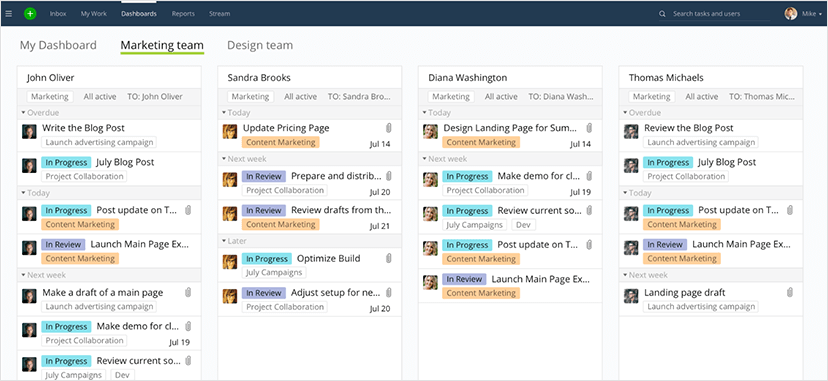
9. Wrike
Wrike is an online project management SaaS product founded in 2006 by Andrew Filev. With Wrike, cross-functional teams can manage projects, workflows, and tasks to help streamline efficient collaboration.
The tool is organized around folders, projects, and tasks. Folders are used to group projects together that are related and can be used by departments or representing high-level initiatives.
Users have multiple ways to view project data within Wrike such as list, board, table, Gantt chart, timelog, resources, analytics and other views. This makes tracking progress easier for teams of all sizes and allows users to customize how they use the program.
Wrike effectively eliminates the need for emails and spreadsheets when it comes to managing projects – a vision set forth by Andrew Filev at its inception over a decade ago.
Features
- Create and configure team workspaces with granular permissions setup
- Integrations with third-party apps such as email, Slack, Zoom, and more!
- Automate work intake with “Dynamic Request Forms.”
- Gain comprehensive insights into your projects and tasks with real-time reporting.
- Get projects up and running quickly with pre-built templates
- Time tracking and digital timesheets to Business plan members and above.
Downside to Wrike
- Limited customer support hours cause difficulty in obtaining help quickly
- Free plan has a limit of 200 tasks and 2GB file space, making it challenging for smaller teams
- Added costs with premium add-ons, potentially leading to up to 3x more expenditure
- Steep learning curve for users new to the software
- Few features and integrations available in the free version
- Lacking collaboration and chat features
Comparison of Wrike to Airtable
If you’re looking for an enterprise-level PM solution, Wrike is the way to go. It’s more expensive but comes with features that enable teams to handle complex projects. Also, with Wrike’s comprehensive toolset, businesses can customize the platform to meet their specific needs and have the assurance of secure collaboration.
However, if you’re a small business with less complicated tasks, Airtable might be the perfect fit. For no cost, you can manage data better than spreadsheets and improve company-wide visibility, all while customizing the interface to match your team’s workflow.
Pricing for Wrike
Wrike offers a FREE plan with no cost for your entire team, as well as PROFESSIONAL and PREMIUM plans at $9.80 and $24.80/month per user, respectively. Unfortunately, for more advanced solutions, you have to contact sales.
Conclusion
What project management tool works best for you? That depends on your team’s size, budget, and workflow.
When choosing the right project management tool, there really is no one-size-fits-all solution. But with so many options available in the market, you’re sure to find a program that suits your needs. Considering each platform’s pros and cons will help you make a smart choice.
For the most intuitive project management platform that’s easy to use, Teamly takes the cake. It offers an impressive set of features and integrations at a reasonable price. The intuitive dashboard helps teams stay organized, while time tracking, task delegation, and collaboration features help increase productivity. With all these advantages, Teamly is certainly worth considering as your go-to project management tool.
















